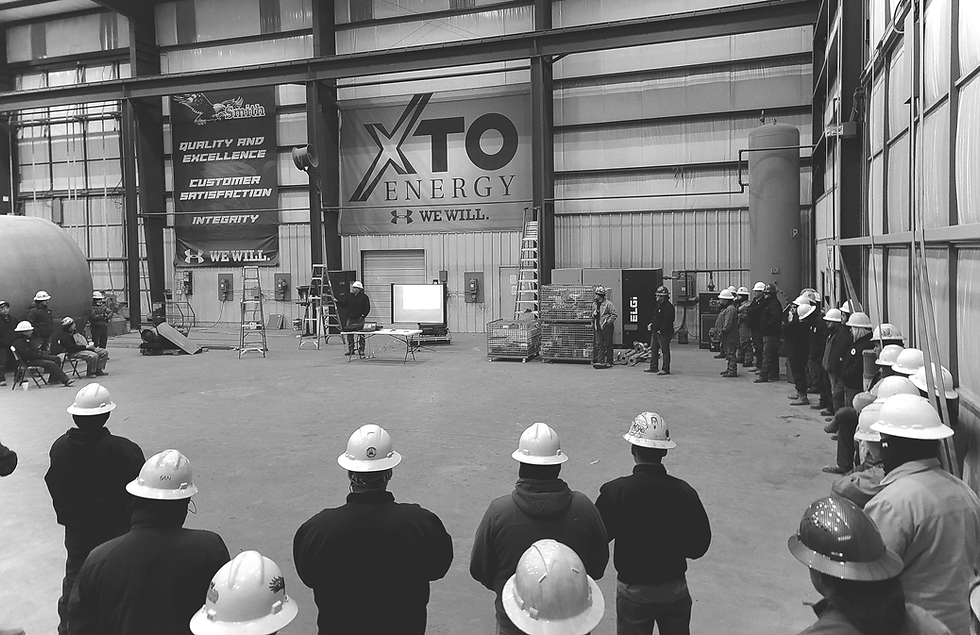Creating a Culture of Safety at Smith Industries
- mwolverton3
- Jan 16
- 3 min read

At Smith Industries, safety is more than a set of policies—it’s a foundational value. The Health, Safety, and Environmental (HSE) Department plays a vital role in fostering a culture of safety, ensuring every employee is aware, engaged, and equipped to prevent incidents and injuries. Through proactive training, data-driven improvements, and open communication, Smith Industries has built a workplace where safety is a collective responsibility.
What Is a Culture of Safety?
A culture of safety refers to an organizational mindset where safety is prioritized at all levels. It’s not just about following rules—it’s about creating an environment where employees actively identify and mitigate risks, share knowledge, and feel empowered to take action to prevent injuries. According to the Occupational Safety and Health Administration (OSHA), a strong safety culture can significantly reduce workplace injuries and improve employee morale.
Smith Industries has embraced this philosophy, weaving safety into its daily operations and long-term goals. Our results speak for themselves consistently strong green standings in the IS Network Systems.
The Role of the HSE Department in Building a Culture of Safety
The HSE Department at Smith Industries is the driving force behind our safety initiatives. Their mission is to create a workplace where incidents are not only minimized but proactively prevented. Here’s how they achieve this:
1. Data-Driven Safety Practices
To improve safety, you need to understand the root causes of incidents. At Smith Industries, the HSE Department analyzes detailed safety data to identify trends and implement targeted solutions. By correlating actions with incidents, we continuously refine our safety protocols to prevent future occurrences.
2. Hazard Recognition and Identification
A critical component of our safety culture is hazard recognition. Employees are trained to spot potential risks in their work environment and take immediate steps to address them. This proactive approach reduces the likelihood of injuries and fosters a sense of shared responsibility for safety.
3. Open Communication and Knowledge Sharing
Strong communication is essential for building trust and maintaining a culture of safety. Our team encourages employees to share lessons learned from past incidents and best practices for avoiding hazards. Monthly safety meetings provide a forum to discuss issues and concerns openly, ensuring everyone’s voice is heard.
Training: The Foundation of a Safe Workplace
Training is a cornerstone of our safety program. Smith Industries provides employees with comprehensive OSHA training sessions each month, ensuring they are well-versed in the latest safety standards and best practices. These sessions cover a range of topics, from equipment handling to emergency response, tailored to the unique challenges of our industry.
Monthly safety meetings complement this training, creating opportunities to address real-time concerns and reinforce key lessons. By maintaining this consistent focus on education, Smith Industries ensures that every employee is equipped to recognize and respond to potential hazards.
The Importance of a Proactive Safety Culture
A culture of safety is not static; it requires ongoing effort and adaptation. Organizations that embrace proactive safety measures, like those at Smith Industries, often see numerous benefits, including:
Reduced Injuries: Proactive hazard identification and mitigation lower the risk of accidents.
Improved Productivity: Employees feel secure and can focus on their work without fear of injury.
Stronger Employee Engagement: A safety-first approach shows workers that their well-being is valued, boosting morale and retention.
Regulatory Compliance: Consistently meeting or exceeding OSHA standards and other regulatory requirements builds trust with clients and stakeholders.
As the National Safety Council (NSC) notes, a robust safety culture contributes to a company’s overall success, underscoring the importance of leadership, employee involvement, and continuous improvement.
Looking Ahead: Sustaining Our Safety Culture
At Smith Industries, safety is not a box to check but a value to uphold. We will continue to evolve our practices, leveraging advanced data analysis, fostering open communication, and maintaining rigorous training programs. As we celebrate our current success, we also look forward to achieving new milestones in safety excellence.
By building and sustaining a culture of safety, Smith Industries sets the standard for what a safe workplace can achieve. Together, we are creating an environment where everyone feels empowered to contribute to our shared goal: an incident- and injury-free workplace.




コメント